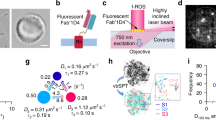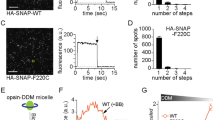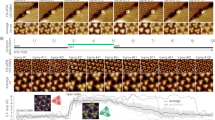Abstract
Individual biological molecules can be imaged under physiological conditions by atomic force microscopy. Our results from AFM, supported by electron microscopy, revealed distinct rows of rhodopsin dimers and paracrystalline arrays in native murine disc membranes1,2. This supramolecular arrangement was also found for the light-activated form, opsin1. We counted 30,000–55,000 rhodopsin molecules per square micrometre, a packing density comparable to that measured by optical methods in amphibian discs3. From the lattice vectors describing the paracrystalline arrays, a maximum possible packing density of 62,900 rhodopsin molecules per square micrometre was calculated. The rhodopsin dimers seen in AFM topographs2 have cytosolic protrusions separated by 3.8 nm, providing an ideal docking platform for arrestin, which has two binding grooves that are separated by 3.8 nm as well1.
Similar content being viewed by others
Fotiadis et al. reply
On the basis of data reported some 30 years ago, Chabre et al. are challenging our observations. Results from their and other3 early experiments, which were all carried out on large ensembles of amphibian disc membranes, indicated that inactivated as well as activated rhodopsin diffuses freely as a monomer in the lipid bilayer. Chabre et al. now propose that the rhodopsin-packing arrangement that we observe by AFM1,2 is induced by the segregation of proteins and lipids at low temperatures.
To respond to this criticism, we recorded electron micrographs as well as AFM topographs of rhodopsin paracrystals on native disc membranes that had been prepared and imaged at room temperature (see http://www.mih.unibas.ch/Nature/Fotiadis.html). Three different surface types could again be distinguished: rhodopsin paracrystals, rhodopsin rafts and the lipid bilayer; at increased magnification, rhodopsin dimers, the building block of the paracrystal, are clearly seen. This dimerization and higher-order organization of rhodopsin at room temperature argues against the claim by Chabre et al. that the packing arrangement we describe1,2 is a result of low-temperature-induced protein–lipid segregation, particularly if we consider that the phase-transition temperature of the bovine-disc lipids is below 3 °C (ref. 4).
Freeze-fracture electron microscopy has also revealed paracrystalline rhodopsin arrays in Drosophila photoreceptive membranes5 and in the plasma membrane of bovine-rod outer segments6. The concept of oligomerization in the presence or absence of ligands is generally accepted for many G-protein-coupled receptors7, and rhodopsin is not an exception.
References
Liang, Y. et al. J. Biol. Chem. 278, 21655–21662 (2003).
Fotiadis, D. et al. Nature 421, 127–128 (2003).
Liebman, P. A. & Entine, G. Science 185, 457–459 (1974).
Miljanich, G. P., Brown, M. F., Mabrey-Gaud, S., Dratz, E. A. & Sturtevant, J. M. J. Membr. Biol. 85, 79–86 (1985).
Suzuki, E., Katayama, E. & Hirosawa, K. J. Electron Microsc. (Tokyo) 42, 178–184 (1993).
Kajimura, N., Harada, Y. & Usukura, J. J. Electron Microsc. (Tokyo) 49, 691–697 (2000).
Bouvier, M. Nature Rev. Neurosci. 2, 274–286 (2001).
Author information
Authors and Affiliations
Corresponding author
Rights and permissions
About this article
Cite this article
Fotiadis, D., Liang, Y., Filipek, S. et al. Is rhodopsin dimeric in native retinal rods?. Nature 426, 31 (2003). https://doi.org/10.1038/426031a
Issue Date:
DOI: https://doi.org/10.1038/426031a
This article is cited by
Comments
By submitting a comment you agree to abide by our Terms and Community Guidelines. If you find something abusive or that does not comply with our terms or guidelines please flag it as inappropriate.



